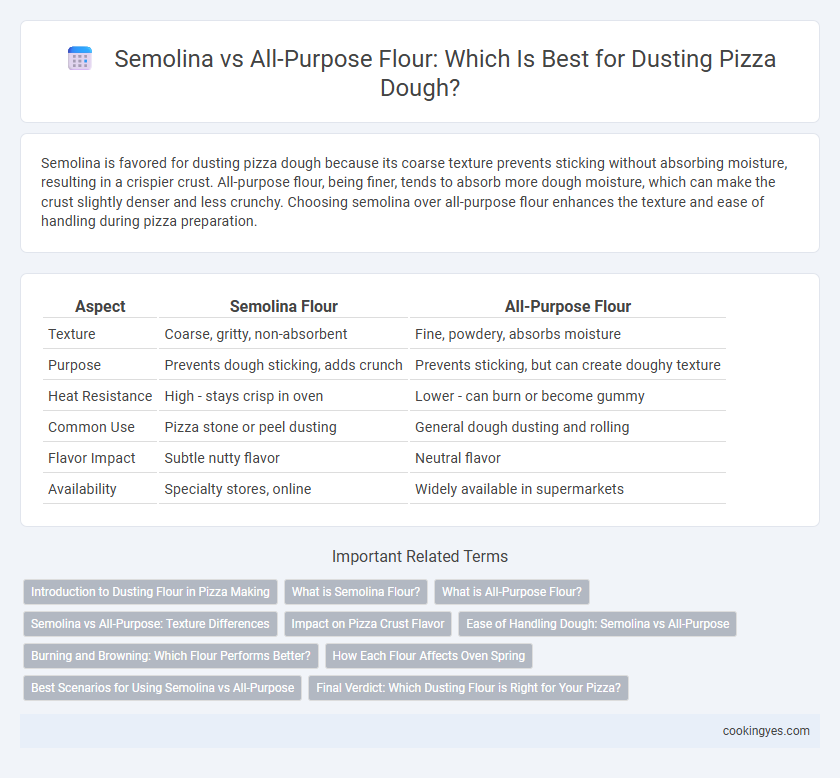Semolina is favored for dusting pizza dough because its coarse texture prevents sticking without absorbing moisture, resulting in a crispier crust. All-purpose flour, being finer, tends to absorb more dough moisture, which can make the crust slightly denser and less crunchy. Choosing semolina over all-purpose flour enhances the texture and ease of handling during pizza preparation.
Table of Comparison
| Aspect | Semolina Flour | All-Purpose Flour |
|---|---|---|
| Texture | Coarse, gritty, non-absorbent | Fine, powdery, absorbs moisture |
| Purpose | Prevents dough sticking, adds crunch | Prevents sticking, but can create doughy texture |
| Heat Resistance | High - stays crisp in oven | Lower - can burn or become gummy |
| Common Use | Pizza stone or peel dusting | General dough dusting and rolling |
| Flavor Impact | Subtle nutty flavor | Neutral flavor |
| Availability | Specialty stores, online | Widely available in supermarkets |
Introduction to Dusting Flour in Pizza Making
Semolina and all-purpose flour serve distinct roles in pizza making, especially as dusting flours that prevent dough from sticking during stretching and baking. Semolina's coarse texture and higher protein content provide a crispier crust and reduce moisture absorption, enhancing dough handling and crust texture. All-purpose flour, finer and more absorbent, offers a smoother surface but may lead to softer edges and increased sticking risk.
What is Semolina Flour?
Semolina flour is a coarse, gritty flour made from durum wheat that is prized for its high protein and gluten content, providing excellent texture and chewiness in pizza crusts. It is often used for dusting pizza dough because its coarse texture prevents sticking without absorbing too much moisture, resulting in crispier crusts compared to all-purpose flour. Unlike all-purpose flour, semolina enhances the structural integrity and adds a subtle, nutty flavor to the pizza base.
What is All-Purpose Flour?
All-purpose flour is a versatile wheat flour blend containing moderate protein levels, typically between 10-12%, suitable for various baking needs including pizza dough preparation. It provides a balanced gluten structure, resulting in a flexible dough that cooks evenly without becoming too tough or too soft. Using all-purpose flour for dusting pizza dough prevents sticking while supporting a slightly chewy crust texture favored in many pizza styles.
Semolina vs All-Purpose: Texture Differences
Semolina flour creates a coarser, grainier texture on the pizza crust compared to the smoother, finer texture achieved with all-purpose flour. Its higher protein content and coarser grind result in a crispy, slightly crunchy base that resists sticking to surfaces better. In contrast, all-purpose flour produces a softer, more pliable crust with less texture variation on the bottom.
Impact on Pizza Crust Flavor
Semolina flour, with its coarse texture and slightly nutty flavor, enhances pizza crust by adding a subtle crunch and depth to the taste profile. All-purpose flour, being finer and more neutral in flavor, results in a softer crust without the flavor complexity semolina provides. Using semolina for dusting can elevate the overall pizza experience by introducing a distinct, toasted note to the crust's flavor.
Ease of Handling Dough: Semolina vs All-Purpose
Semolina flour's coarse texture provides superior resistance to sticking, making dough easier to handle and shape compared to all-purpose flour's finer particles. The granular nature of semolina aids in effortless sliding and transferring of dough without compromising its structure. In contrast, all-purpose flour can absorb moisture more readily, increasing stickiness and complicating dough manipulation.
Burning and Browning: Which Flour Performs Better?
Semolina flour has a higher protein content and coarser texture, which helps it resist burning and promotes better browning when used for dusting pizza dough. All-purpose flour, being finer and lower in protein, tends to burn more easily under high oven temperatures, resulting in less desirable browning. For optimal crust development and crispness without burning, semolina is the preferred dusting flour over all-purpose.
How Each Flour Affects Oven Spring
Semolina flour, with its coarse texture and higher protein content, creates a slightly grittier surface that prevents dough from sticking and promotes better oven spring by allowing more steam to escape during baking. All-purpose flour, being finer and less absorbent, can sometimes lead to a denser crust with less lift as it retains more moisture on the dough's surface. Using semolina for dusting enhances the crust's crispness and oven spring, resulting in a lighter, airier pizza.
Best Scenarios for Using Semolina vs All-Purpose
Semolina flour, with its coarse texture and high protein content, is ideal for dusting surfaces and pizza peels to prevent sticking without absorbing too much moisture, especially in Neapolitan or wood-fired pizzas. All-purpose flour, being finer and more absorbent, works well on home kitchen countertops and in recipes that require a softer, less gritty crust texture. Choosing semolina is best when seeking a crispier bottom crust and easier dough release, while all-purpose flour suits everyday baking and dough handling with less risk of grittiness.
Final Verdict: Which Dusting Flour is Right for Your Pizza?
Semolina flour offers a coarser texture that prevents sticking and adds a subtle nuttiness, enhancing the pizza crust's flavor and crispiness. All-purpose flour provides a finer, more neutral dusting that minimizes browning and is easier to clean from surfaces. For authentic, crispy pizza crusts with added texture, semolina is the preferred dusting flour, while all-purpose flour suits everyday pizza making for its convenience and softer finish.
Semolina vs All-purpose for dusting flour Infographic

 cookingyes.com
cookingyes.com